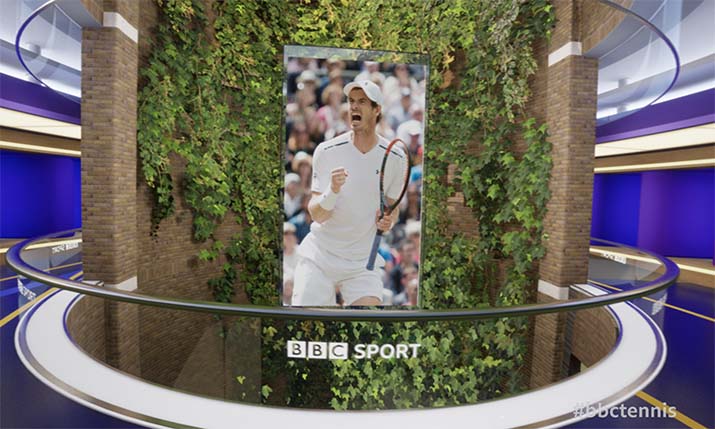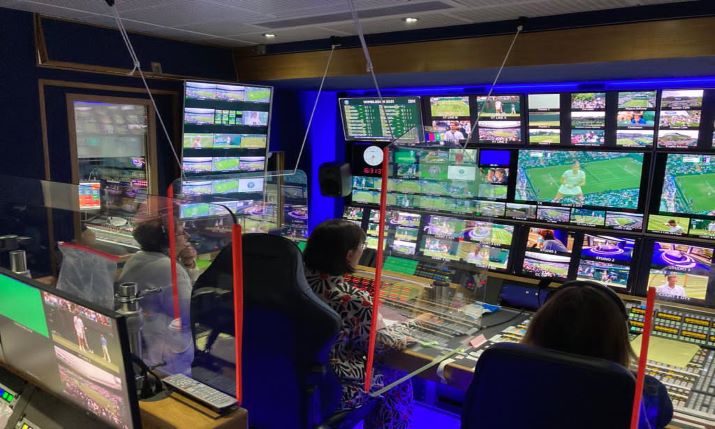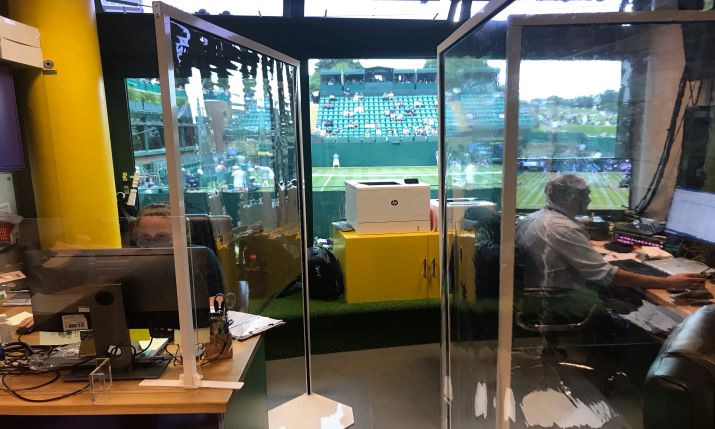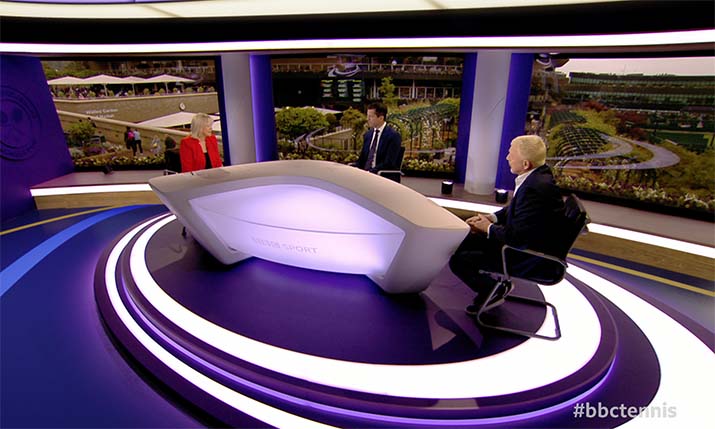Strawberries and cream: BBC Sport taking advantage of a great return to Wimbledon for The Championships

Wimbledon 2021 has challenged BBC Sport’s production, but it has overcome the obstacles and is enjoying the Championships
The Championships is back and BBC Sport is on site at Wimbledon to bring all the excitement and drama of this world-renowned Grand Slam back to our screens after its 2020 hiatus.
This year the BBC has worked with host broadcaster, Wimbledon Broadcast Services’ (WBS), to minimise crew on site, reconfigure studios and offices, and work out how to make the most of the strawberries and cream while maintaining social distancing.
BBC Sport has a new virtualised studio on site that it has developed alongside technical partner, Moov, on which Ron Chakraborty, BBC Sport’s lead executive for major events and head of the Championships broadcast for the British incumbent, comments: “In this sort of trying year, when there are a lot of challenges for our production, to have something new that we can show off is really nice; a nice bonus.”
Yet the broadcaster also has other studio areas to consider, all of which needed refining for social distancing. Chakraborty says: “Studio-wise, obviously the main studio was fine, although we’re sitting two metres apart, but we knew that the platform up on the hill that we do the highlight show from was way too crammed to have Claire Balding and two guests. So Wimbledon built a new platform with social distancing in mind, which both us and ESPN are using. We used it this morning [Wednesday 30 June] with Sue [Barker] and Boris Becker and Sam Smith all safely distanced.”
BBC Sport is working on a schedule with ESPN for the platform on the hill, which includes gaps to allow the area to be fully sanitised.

Part of BBC Sport’s crew working on site at Wimbledon 2021 in technical partner, Arena’s, OB truck
Challenging play
As to those challenges mentioned by Chakraborty, this year there have been many for the BBC Sport team and their OB supplier, Arena. He states: “[There have been a] lot of challenges. I suppose space is the first part of it. Wimbledon have been brilliant. They’re always very organised and I’ve seen the various challenges that the other majors have faced and also other sporting events have faced, and worked out how they were going to do it. But every venue is unique and Wimbledon has its own unique challenges.
“For us it’s probably three areas when it comes to the space part of it,” he goes on. “One is the broadcast centre, then the other areas are studios, commentary boxes, and then I suppose, player access as well.
“So the broadcast centre was tough,” Chakraborty explains. “It’s been around a while, about 30 years, and I think as more and more people and more and more [TV] platforms come and have filled it up, suddenly our office and the one next door have got about 20 people in there; [but] once we put in social distancing, there’s got to be [no more than] five in [this office] and five in [the other]. So you [have to] work out where does everybody go?
“I think the fans have really reacted warmly [to the on-court interviews], especially Murray on the first night. Every answer seems to get cheered, and I think the players react well to that as too as they’ve spent most of the year playing to empty stands so actually having a Wimbledon back – the one of the four Grand Slams that wasn’t there last year – has been really special to them”
“What Wimbledon worked out pretty quickly was they did a survey of all their rights holders and said, “well, who’s coming and who’s not, and for people who are coming, please make your delegations as efficient as they can be and tell us how many people you’re bringing”. So once they’d done that, they worked out how much space was available and where [they could] go.
“[However] at the same time the pressure was on us to say, well, how much of the operation needs to be here? And we knew that the main broadcast scanner – OB truck – had to be here because there’s so many feeds coming in from all over the complex. But we decided we could take a lot of our post production back up to Salford. So four of our six edit suites are back in Salford, [plus] the ingest operation, library,” Chakraborty continues.
Those four edit suites that have been moved to Salford would have been situated in portacabins on site in London, so now that space has been freed up, staff that have to be on site have been spread across the two offices within the broadcast centre and those cabins.
Chakraborty adds: “Similarly, we’ve got about 40 commentators who are [normally] all packed into one room; that changed [with social distancing] and Wimbledon created three offices so they’re all spread out in there. They’re all sort of sat opposite each other at a two metres distance. So that’s how we’ve kind of worked that part of it, just to try and use the space as efficiently as possible. Obviously we’re surrounded by perspex screens. The moment you leave your desk, you’re putting your mask on. So all the kind of standard challenges you’ve got of any sports event really.”
Including staff in the OBs on site in a regular year, BBC Sport would have around 200 people at Wimbledon. This year, thanks to pulling crew up to Salford to work remotely and minimising people on-site as much as possible, that figure is down by one third.
BBC Sport’s Wimbledon social media team is also in Salford this year, and it is going well. Says Chakraborty: “We seem to be doing all right there. We filmed an opening that we thought was a bit of an old school TV thing, like a gag with Tim Henman and Boris Becker yesterday [Tuesday 29 June] looking forward to the football [England V Germany], and it seems to be approaching one hundred thousand views on Instagram. So you never know what goes down well with the kids!”

One of BBC Sport’s offices in he broadcast centre at Wimbledon. Ron Chakraborty, BBC Sport’s lead executive for major events and head of the Championships broadcast, on the right
Strawberries and bubbles
Player access seemed to be an issue for BBC Sport because the players are far more limited in their movements this year, but it is working well, Chakraborty says. “Player access is the other [challenge]. They’ve obviously got the player bubble, and all the players aren’t in their usual houses around Wimbledon; they’re all in the Crowne Plaza hotel at Westminster in their own bubble. So the interaction between us and players is not what it was. We still can do face-to-face interviews, but they’ve all got to be outside. Wimbledon has set up a camera in the hotel so if we want to do down the line interviews with the players later on [so we can] get them on the highlights, we could speak to them from the hotel. So that’s worked really well.”
“If there’s one thing the last 12 to 18 months have shown us [it’s that] a lot of remote working practices do work very well, and obviously with a view on sustainability and reducing travel, these systems do work”
Some aspects of player access have been extremely successful, Chakraborty notes: “And then finally on the court, obviously we’re used to the players coming into the little flash interview area. We’re having to do those on the court, and actually they’ve been one of the successes so far. I think the fans have really reacted warmly [to the on-court interviews], especially Murray on the first night. Every answer seems to get cheered, and I think the players react well to that as too as they’ve spent most of the year playing to empty stands so actually having a Wimbledon back – the one of the four Grand Slams that wasn’t there last year – has been really special to them.
“I think not just the players, but even the broadcasters have been so positive about being back here,” he adds. “So I think in strange way that move of moving the interviews out onto the courts has been forced upon us, but actually it’s been quite positive, and you never know, it may stay in future.”

BBC Sport’s new virtualised studio on location at Wimbledon
Spectacular shots for sharing
On what of the host broadcaster’s innovations bought in for the Championships 2019 are coming in particularly useful this year, Chakraborty comments: “[Wimbledon has] extended [the cablecam running through the venue launched in 2019], so it’s even better now. We’ve got some fantastic shots from there.
“In terms of other [useful innovations at Wimbledon], I think content sharing has been a crucial part of it too, [enabling us to] minimise the amount of crews and so on that do interviews and bits of filming. [Wimbledon has] got their central content store and if they’ve got an exclusive, they make it available to everybody; so for example, like Serena Williams leaving [on Tuesday 29 June] and being interviewed in the dressing room, that was available [to all on the media server] rather than all the crews coming in. So I think that availability and opportunity for broadcasters to share and pool footage is really useful given that so many of them aren’t on site.”
As to what changes BBC Sport would continue and which it would revert back to in 2022 if it could, Chakraborty comments: “I think there’s definitely an argument for the edits back in Salford. If there’s one thing the last 12 to 18 months have shown us [it’s that] a lot of remote working practices do work very well, and obviously with a view on sustainability and reducing travel, these systems do work. We’ve got those facilities in Salford and so far everything’s working really smoothly. Going back to having the full studios that we used to have and three in the commentary box [rather this year’s limit of two], those restrictions hopefully won’t be with us next year.
“But certainly when it comes to the overall operation, I can definitely see parts of it back in Salford, some of them staying long term,” Chakraborty concludes.
